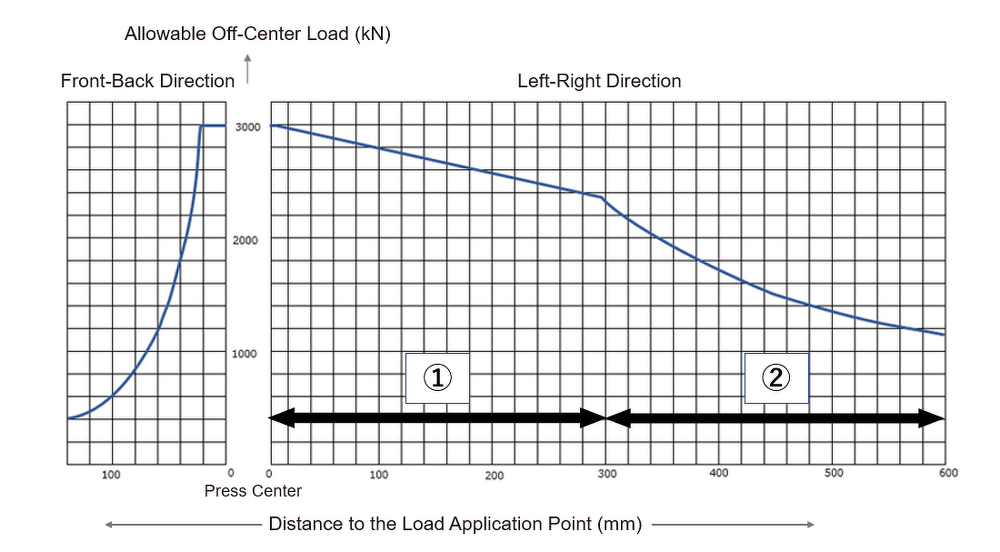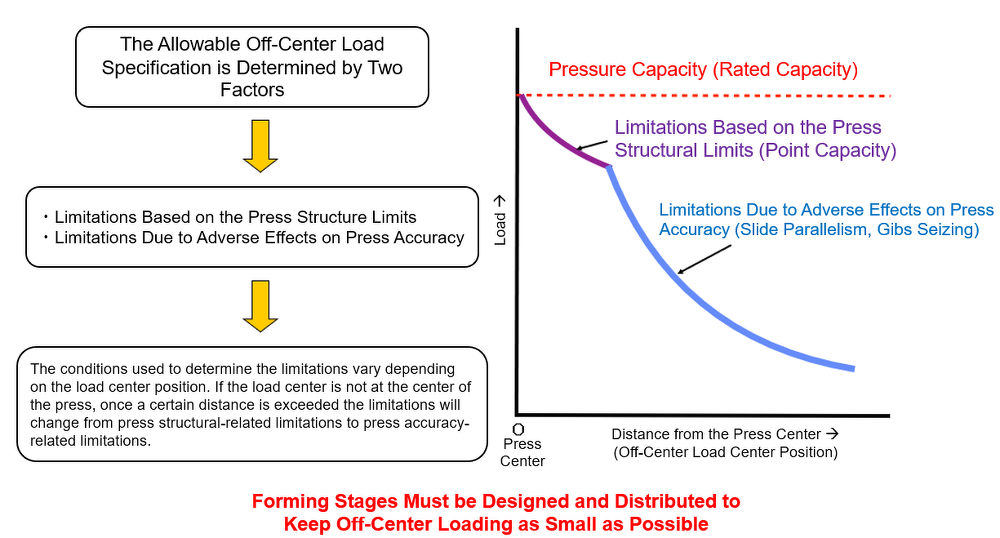
Allowable Off-Center Load Diagrams--Part ②
In our previous blog post titled "Allowable Off-Center Load Diagrams--Part ①," we talked about cases where the load center is some distance from the center of the press (i.e., there is off-center loading) and that due to the characteristics of the press being used that there will be limitations to the total forming load of the press even when using the press below its rated capacity.
We also talked about the Allowable Off-Center Load Diagrams that show the total forming load limitations of a press, and in this blog post we will explain the conditions a press manufacturer takes into consideration when creating an Allowable Off-Center Load Diagram. We hope this information will be of use to you when you are reviewing the Allowable Off-Center Load Diagram for your press.

Fig. 1: A Sample "Allowable Off-Center Load Diagram"
Allowable Off-Center Load Diagrams--Point No. 1: Press Design Limits (Suspension Point Capacity)
A manufacturer will first consider the structural design limitations (the suspension point capacity) of the press in question. (Fig. 1-①)
When using a 2-point press for multi-stage forming, etc., if the load center is some distance from the center of the press, the percentage of the load applied on the suspension point closest to the load center will be higher than the load applied on the suspension point that is farther away.

(※Off-Center Load Center = The left & right points' "Load x Distance" balance point)
The load applied on each suspension point due to the load center position cannot exceed the capacity of the suspension points (in the case of a 2-point press, the capacity of each suspension point is 1/2 the rated capacity of the press). So looking at the above example, the load being applied on the left point exceeded 1500 kN, so this forming cannot be done even though the total forming load is less than the rated capacity (pressure capacity) of the press. The farther the load center is from the center of the press, the lower the total possible forming load will become. In such a case, you must either shift the load center closer to the center of the press or select a press with a higher capacity rating.
Allowable Off-Center Load Diagrams--Point No. 2: The Effects of Off-Center Loads on Press Accuracy
Next, the press manufacturer will consider limitations that influence the accuracy of the press. (Fig. 1-②)
Placing limitations on only the suspension point capacity will not address the slide tilt issue that occurs due to off-center loads, and areas of concern regarding the adverse effects off-center loads include the precision of the press, damage to the dies, and the seizing of slide guides, etc.
Accordingly, we set limits based on the characteristics of each press and the targeted product using JIS-specified static accuracy (parallelism) as a guide.
For example, in the case of a high-precision press we want to keep parallelism degradation as low as possible, so we create the diagram based on JIS Class 1, and in the case of a general-purpose press, we create the diagram based on JIS Class 2 or Class 3.
The following shows the process for creating an Allowable Off-Center Load Diagram.

Explanation of the Allowable Off-Center Load Diagram
A Final Word....
Did you find this helpful? Even if you were to form products while staying within the allowable load values calculated using the Allowable Off-Center Load Diagram, having an off-center load can adversely affect the press accuracy and the dies, and thus it is preferable to minimize the off-center loading conditions as much as possible.
Please use your press in a way that will keep it well within the allowable limits.
